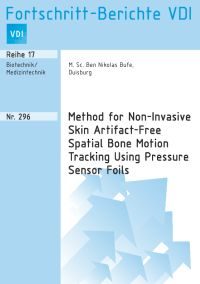Method for Non-Invasive Skin Artifact-Free Spatial Bone Motion Tracking Using Pressure Sensor Foils

Erscheinungsdatum: 23.10.2019
Reihe: 17
Band Nummer: 296
Autor: M. Sc. Ben Nikolas Bufe
Ort: Duisburg
ISBN: 978-3-18-329617-0
ISSN: 0178-9600
Erscheinungsjahr: 2019
Anzahl Seiten: 92
Anzahl Abbildungen: 53
Anzahl Tabellen: 15
Produktart: Buch (paperback, DINA5)
Produktbeschreibung
This work addresses the development of a novel method for bone pose estimation that is both,non-invasive and accurate. The main principal is to palpate three prominent bone protuberancesusing pressure sensor planes attached to the skin. Bone protuberances are approximatedby three ellipsoids that are rigidly attached together. The general formulation of the constraintequations is presented and, as a solution approach, an optimization cost function is proposedallowing bone pose tracking that is insensitive toward input errors. The method is validated invivousing dual fluoroscopy yielding bone tracking precisions in the submillimeter range andbelow 1 degree, thus, reaching the same order of magnitude as state of the art model basedtracking techniques. Finally, the general approach is extended to automatically approximate therigid body bone geometry via pressure sensor palpation that allows to fully circumvent radiationexposure, making this approach universally applicable.
Contents
1 Introduction
1.1 Motivation
1.2 State of the art
1.2.1 Invasive Procedures
1.2.2 Non-invasive Procedures
1.3 Objective and overview
2 Geometrical problem analysis for the planar case
2.1 2D model description
2.2 Formulation of the constraint equations
2.3 Characteristics of a symmetric configuration
2.4 Determination of the solution variety using Gr¨obner bases
2.4.1 Gr¨obner bases
2.4.2 Application examples
2.4.3 Sensitivity analysis
2.4.4 Reduction of the solution variety
3 3Dpose estimation based on the ellipsoid-approximated bone mode
3.1 Formulation of the constraint equations
3.2 Optimization problem
3.3 Sensitivity analysis
4 Self-adjusting point for bone pose estimation 28
4.1 Three-point model description
4.2 Self-adjusting parameter approximation
4.3 Approximation-error expectation
5 Validations
5.1 Pressure mapping
5.1.1 Materials and Methods
5.1.2 Results
5.1.3 Discussion
5.2 Ellipsoid-approximated bone model validation
5.2.1 Materials and Methods
5.2.2 Results without initial guess
5.2.3 Results with initial guess
5.2.4 Discussion
5.3 Influence factors of manual 2D-3D registration
5.4 Point-approximated bone model validation
5.4.1 Materials andMethods
5.4.2 Results
5.4.3 Discussion
6 Conclusions and outlook
6.1 Conclusions
6.2 Outlook
Appendices
A Geometrical problem analysis for the planar case
Contents VII
A.1 General solutions
B 3D pose estimation based on the ellipsoid-approximated bone model
B.1 Reference pose for sensitivity analysis
C Validation
C.1 Calibration Pencil
C.2 Residuals – ellipsoid-approximated bonemodel
C.3 Residuals – point-approximated bonemodel
C.4 Parameters – ellipsoid-approximated bone model
C.5 Parameters – point-approximated bonemodel
Bibliography
Abstract
The knowledge about skeletal kinematics is essential in many biomechanical and medical applications. However, an accurate, non-invasive and radiation-free method for bone motion tracking is still an open issue. This thesis addresses the development of a novel method for bone pose estimation that is both, non-invasive and accurate. The main principal is to palpate three prominent bone protuberances using pressure sensor planes attached to the skin. Bone protuberances are approximated by three ellipsoidsthat are rigidly attached together.
At first, the geometrical problem of the planar case is analyzed, where ellipsoids become ellipses and sensor planes become lines. After deriving the constraint equationsdescribing the mathematical model of the system, Gr¨obner bases are used to find the number of possible solutions for two different numerically defined configurations of thelines and the ellipses. As a result, a maximum number of 32 different real solutions
for the symmetrical and a maximum number of 64 different complex and real solutions for the general case are obtained. However, using the example of the symmetric case, it can be shown that the solution variety can be significantly reduced. From the 32 real solutions only three solutions are physically plausible, taking into account that pressure points are generated by an ellipse arc facing the lines.
This work also presents the general formulation of the constraint equations for the three dimensional case. As a solution approach, an optimization cost function is proposed including the squared minimal distances between sensors and ellipsoids allowing bone pose tracking that is insensitive toward input errors. Furthermore, a dual fluoroscopy validation of the method for three basic movements of the shank: flexion/extension, abduction/adduction and internal rotation is presented. It is shown that by pressure sensor palpation, bone tracking precisions of 0.5 mm to 1.0 mm and 0.3◦ to 0.6◦ can be attained with respect to dual fluoroscopy manual registration, thus, reaching the same order of magnitude as state of the art model based tracking techniques.
Finally, this thesis regards the limiting case where ellipsoids become points allowing the introduction of an automatable procedure approximating the rigid body bone geometry based on data from a previously performed bone pose measurement. Thereby, it is possible to fully circumvent radiation exposure that might be necessary to extract ellipsoid parameters from e. g. a computed tomography scan. Results indicate that deviations to the ellipsoid-approximated bone model are in the submillimeter range and may thus be negligible for many applications.
Keywords: In-vivo bone motion tracking, Non-invasive, Skin artifact-free, Radiation-free point-model approximation, Pressure-foil palpation, Three-Ellipsoid 2D-3D registration, Pressure point identification, In-vivo bone motion tracking, Non-invasive, Skin artifact-free, Radiation-free point-model approximation, Pressure-foil palpation, Three-Ellipsoid 2D-3D registration, Pressure point identification
* Der VDI-Mitgliedsrabatt gilt nur für Privatpersonen
